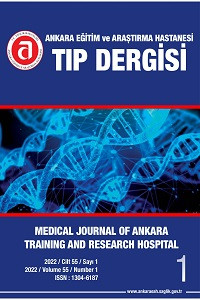Abstract
AMAÇ: Ailevi Akdeniz Ateşi (AAA) ateş ve serozit atakları ile karakterize otozomal resesif geçişli genetik bir hastalıktır. Tanı Tel-hashomer kriterlerine göre konulur. Genetik testler tanıyı desteklemeye yönelik yardımcı yöntemlerdir. Çalışmamızın amacı genetik testlerin fenotip, subklinik inflamasyon ve komplikasyonlarla ilişkisini değerlendirmektir.
GEREÇ VE YÖNTEM: Çalışmaya 2000-2020 yılları arasında nefroloji polikliniğinde takip edilen, ek hastalıkları olmayan, genetik testleri çalışılmış 97 AAA hastası alındı. Tüm hastaların demografik,klinik özellikleri ve laboratuvar verileri kaydedildi. . Hastalar genetik özelliklerine göre üç gruba ayrıldı. Grup I M694 V homozigot mutasyonu olan, grup II M694V heterozigot veya M694V birleşik heterozigot olan, grup III M694 V dışı homozigot, heterozigot veya birleşik heterozigot olan hastalardan oluştu. Verilerin karşılaştırılması yapıldı.
BULGULAR: Hastaların yaş ortalaması 36.64±10.78, teşhis yaşı 25.05±1.47, takip süresi 6.3±4 yıldı. En sık görülen semptom %88.7 ile karın ağrısıydı. Hastaların %26.8’de subklinik inflamasyon tespit edildi. %13.4’üne böbrek biyopsisi yapıldı. Tanı anında hastaların %16.5’da kronik böbrek hastalığı varken 6.3 yıllık takip sonrası bu oran %27.8 yükseldi. Üç grup arasında klinik bulgular açısından anlamlı farklılık bulunmadı. Ancak grup-1’de kas-iskelet sistemi bulguları daha ön plandaydı. CRP ve fibrinojen düzeyi grup-I ve II’de anlamlı yüksek bulundu.
SONUÇ: AAA hastalarında genetik test yaptırılıp özellikle M694V homozigot muatsyon tespit edildiyse ataklar ve subklinik inflamasyon açısından hastalar yakın takip edilmelidir. Kontrollere geldiklerinde atak döneminde olmasalar bile CRP, fibrinojen gibi inflamatuvar parametreler ölçülmelidir. Yüksek değerlere sahip olan hastalar, AA amiloidoz, kronik böbrek hastalığı gibi komplikasyonlara karşı yakın takip edilmelidir.
Keywords
AA Amiloidoz Ailevi Akdeniz Ateşi Kronik böbrek hastalığı M694V mutasyonu Subklinik inflamasyon
References
- 1-Ben-Chetrit E, Levy M. Familial Mediterranean fever. Lancet 1998; 351:659–64.
- 2-Chae JJ, Aksentijevich I, Kastner DL. Advances in the understanding of familial Mediterranean fever and possibilities for targeted therapy. Br J Haematol 2009;146:467–78.
- 3- Tunca M, Akar S, Onen F, et al. Familial Mediterranean fever (FMF) in Turkey: results of a nationwide multicenter study. Medicine. 2005;84:1-11.
- 4- Soylemezoglu O, Kandur Y, Duzova A, et al. Familial Mediterranean fever with a single MEFV mutation: comparison of rare and common mutations in a Turkish paediatric cohort. Clinical and Experimental Rheumatology. 2015;33:152-5
- 5- Bakkaloglu A. Familial Mediterranean fever. Pediatr Nephrol. 2003;18:853-9.
- 6-Kasifoglu T, Bilge SY, Sari I, et al. Amyloidosis and its related factors in Turkish patients with familial Mediterranean fever: a multicentre study. Rheumatology (Oxford). 2014 ;53:741-5
- 7- Üreten K, Gönülalan G, Akbal E, et al. Demographic, clinical and mutational characteristics of Turkish familial Mediterranean fever patients: results of a single centerin Central Anatolia Rheumatol Int. 2010; 30:911–5
- 8-Ece A, Çakmak E, Uluca Ü, et al. The MEFV mutations and their clinical correlations in children with familial Mediterranean fever in southeast Turkey Rheumatol Int .2014 34:207–12
- 9- Aldea A, Calafell F, Arostegui JI, et al. The west side story: MEFV haplotype in Spanish FMF patients and controls, and evidence of high LD and a recombination “hot-spot” at the MEFV locus. Human Mutation.2004;23:399.
- 10-Van der Hilst JC, Simon A, Drenth JP. Hereditary periodic fever and reactive amyloidosis. Clin Exp Med. 2005;5:87–98.
- 11-Celkan T, Celik M, Kasapcopur O, et al. The anemia of familial Mediterranean fever disease. Pediatr Hematol Oncol. 2005;22:657–65.
- 12- Duzova A, Ozaltin F, Ozon A, et al. Bone mineral density in children with familial Mediterranean fever. Clin Rheumatol. 2004;23:230–4.
- 13- Babaoğlu H, Armagan B, Bodakci E , et al. Predictors of persistent inflammation in familial Mediterranean fever and association with damage. Rheumatology (oxford).2020 Aug 10:keaaa378.doi.10.1093 /rheumatology/keaa378. Online ahead of
- 14- Bayram MT, Çankaya T, Bora E, et al. Risk factors for subclinical inflammation in children with Familial Mediterranean fever. Rheumatol Int. 2015 Aug;35:1393-8
- 15-Ben-Zvi I, Livneh A. Chronic inflammation in FMF: markers, risk factors, outcomes and therapy. Nat Rev Rheumatol. 2011;7(2):105–112
- 16- Ozen S, Demirkaya E, Amaryan G, et al. Results from a multicentre international registry of familial Mediterranean fever: impact of environment on the expression of a monogenic disease in children. Ann Rheum Dis. Ann Rheum Dis. 2014 ;73:662-7
- 17-Mukhin N A, Kozlovskaya LV, Bodganova M V, et al. Predictors of AA amyloidosis in familial Mediterranean fever. Rheumatol Int. 2015;35:1257-61
- 18- O’Hara R, Murphy EP, Whitehead AS, et al. Acute-phase serum amyloid A production by rheumatoid arthritis synovial tissue. Arthritis Res. 2000; 2:142–8
- 19-Yalcinkaya F, Ozcakar ZB, Tanyildiz M, et al. Familial Mediterranean fever in small children in Turkey. Clin Exp Rheumatol. 2011; 29:87–90
- 20- Sönmez HE, Esmeray P, Batu ED, et al. I s age associated with disease severity and compliance to treatment in children with FMF? Rheumatol Int. 2019;39:83-7
- 21- Ozcakar ZB, Yalcinkaya F, Yuksel S, et.al. Possible effect of subclinical inflammation on daily life in familial Mediterranean fever. Clin Rheumatol. 2006;25:149–52
- 22- Duzova A, Bakkaloglu A, Besbas N, et al. Role of A-SAA in monitoring subclinical inflammation and in colchicine dosage in familial Mediterranean fever. Clin Exp Rheumatol. 2003;21:509–14
- 23- Stankovic Stojanovic K, Hentgen V, Fellahi S, et al. Concordance between CRP and SAA in familial Mediterranean fever during attack-free period: a study of 218 patients. Clin Biochem. 2017;50:206–9.
Details
| Primary Language | Turkish |
|---|---|
| Subjects | Clinical Sciences |
| Journal Section | Original research article |
| Authors | |
| Publication Date | April 30, 2022 |
| Submission Date | April 16, 2021 |
| Published in Issue | Year 2022 Volume: 55 Issue: 1 |

